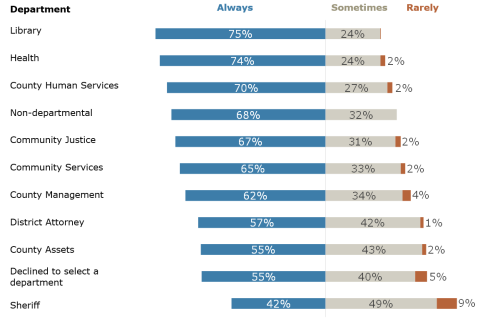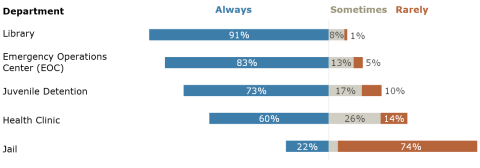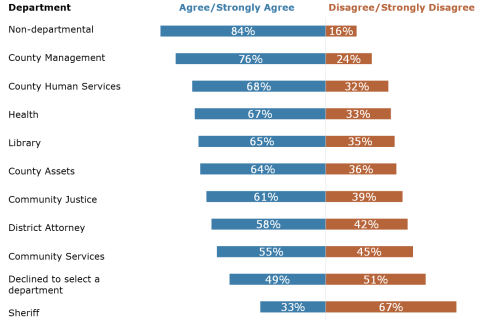Guidance to departments and employees: Guidance is thorough; employees report implementation gaps
Guidance
Why did we look at centralized guidance? Why is it important?
Centralized guidance is guidance and policies from central county leadership to departments and employees. The existence of guidance alone is not enough to ensure a safe workplace, but is a necessary first step.
The county provides critical services to the community and has over 5,000 employees. Many services cannot be done remotely. It is important that the county operate safely to protect the people it serves, its workforce, and the public, as well as ensure that critical services can continue uninterrupted.
What guidance is the county providing to departments and employees about operating safely during the pandemic?
Central Human Resources put together centralized guidance for county operations during the pandemic. The guidance is published on the county’s intranet. It is available to all employees.
Policies and guidance have changed over time. Guidance continues to change. At the time of our audit, the guidance covered topics including: masks/face coverings, health screenings, cleaning and disinfecting, strategies to reduce employees on site, and physical distancing in shared/public spaces.
Examples of guidance and policies:
- Onsite and field staff are required to wear masks or face coverings, except in private individual work spaces.
- Many staff are required to confirm they are symptom free before work, through temperature checks or written or verbal statements.
- Workstations should be spread out and access to shared spaces should be reduced.
Management established most guidance quickly. Additional guidance was added over time. For example, guidance with minimum standards for making workspaces safe was added in August 2020.
Public Health also publishes guidance for the community on the county’s public-facing website. Some of this guidance applies to contracted service providers, like nonprofit homeless shelter providers.
What centralized guidance is the county providing to employees about sick leave and other supports?
Information about sick leave and supports is available on the county’s intranet.
Changes that the county made to sick leave policy in response to COVID-19 include:
- Allowing employees to borrow from future leave
- Up to 80 hours of additional paid leave for COVID-19 related reasons, in accordance with new laws
- Expanding the catastrophic leave program, which allows employees to donate leave time to other employees facing catastrophes
- Allowing employees to telework when they have a dependent at home
The county also shared information about the employee assistance program (EAP) and wellness support in emails to employees and on the intranet.
How does county guidance compare with CDC, state, and other guidance?
We compared the county’s guidance and policies to guidance from the Centers for Disease Control and Prevention (CDC), State of Oregon Health Authority, Oregon Occupational Safety and Health (OSHA), and Johns Hopkins University.
Overall, the county’s guidance was thorough and was in alignment on nearly all of the recommended topics from these sources.
At the time of our audit, four areas of the county guidance did not align with national and state guidance. However, the county is working on most of these in response to new OSHA requirements. These areas are:
- Risk Assessment and Planning: At the time of our audit, the county had not yet conducted a formal risk assessment or hazard assessment. This kind of assessment could provide a framework for decision-making. The CDC and Johns Hopkins recommend conducting a risk assessment. In November 2020, OSHA released new requirements for risk assessments and the county has started that process. OSHA also requires an infection control plan. A workplace specific plan is also a CDC recommendation.
- Input and Feedback: While county leadership has done a lot to solicit employee input, more could be done. The CDC recommends designating a COVID coordinator and sharing that information with employees as a point of contact. County leadership has designated a social distancing officer, but has not shared their information as a point of contact to all employees. Additionally, Johns Hopkins recommends a centralized place for employees to provide anonymous feedback, which the county has not offered.
- Exposure Plan: The county is revising protocols on what to do when an onsite employee tests positive for COVID-19. Previous guidance for managers on this topic primarily involved notifying HR and holding a management meeting to discuss the situation. It left notification of close contacts to the public health contact tracing process. The guidance was not on the intranet at the time of our audit. However, the county is currently revising the protocols for potential exposures due to new OSHA requirements. The new protocols will include a process for notifying employees of a potential exposure.
- Training and Information: The county has provided a lot of information on new policies and about COVID-19. In December 2020, the county also released required training on these topics. Information and training was another new OSHA requirement.
In fall 2020, we sent a survey to all county employees to provide them with an opportunity to communicate their experiences during the pandemic. Employees reported concerns in our survey related to the potential of workplace exposure. Some employees expressed concerns about not knowing what would happen if someone at their workplace tested positive. Employees were both concerned about a lack of a plan and wanted information for their own health.
Guidance in Practice
What controls does the county have in place to ensure departments are following guidance?
County leadership works with departments on approving changes in operations and providing advice.
Over the summer, the county went through a process for departments to present service plans to central leadership. The plans described changes to increase any in-person services, or keep services remote. The Chair made final decisions about the plans, in consultation with other county leaders and experts. As new situations arise, that process can be repeated, as needed.
The Chief Operating Officer and Chief Human Resources Officer reported that they meet regularly with department heads to discuss safety steps. They also rely on traditional complaint methods to detect problems, such as OSHA complaints, HR complaints, and union grievances. County policies on COVID-19 safety measures are like any other county policy and can result in discipline. Staff with expertise, like staff from Facilities, consider themselves as consultants, and do not oversee implementation.
Are departments following guidance?
According to our survey of employees, departments could improve their implementation and enforcement of guidance, as described below.
Masks and face coverings
The survey showed generally good compliance with the masks and face coverings policy but there is room for improvement.
When asked if county employees wore face coverings, most respondents said county employees wore face coverings always (64%) or sometimes (33%).
The question, “In my experience, county employees wear masks or face coverings when working with the public or within 6 feet of others,” matched county policy at the time of the survey. All county employees should always wear masks under those circumstances.
Employees in the Sheriff’s Office and those who declined to provide the department they worked for had the least positive responses. Library and Health Department employees had the most positive responses.
Survey question: In my experience, county employees wear masks or face coverings when working with the public or within 6 feet of others.

Respondents reported that the public wore face coverings less frequently than staff, with 38% saying that service users and community members always wear face coverings and 54% saying they sometimes wear face coverings when in county facilities or interacting with county employees. Again, answers varied by department.
We worded the question to match general county policy but it does not apply precisely in all settings. For example, once adults in custody have completed a quarantine period, they are not required to wear masks in their housing unit.
Survey question: In my experience, service users (e.g. clients, patients, people in custody) and community members wear masks or face coverings when in county facilities or when interacting with county employees.
In another question, most respondents agreed or strongly agreed that management enforces the face covering policy (84%). The lowest levels of agreement were from respondents who declined to answer what department they worked for, those from the Sheriff’s Office, and those from the Department of Community Services. The Department of Community Services includes Transportation, Animal Services, and Elections.
Health screenings
County policy requires symptoms checks before starting shifts in several workplace settings. At the time of the employee survey, employees at health care settings were supposed to have temperature checks prior to starting a shift. Employees at Libraries, the Emergency Operations Center, and Corrections Health were to state in writing that they do not have COVID-19 symptoms at the beginning of each shift. Employees in jails, juvenile detention settings, and homeless shelters were to verbally tell their managers that they are symptom free.
According to the employee survey, the county policy on health screenings appears to be unevenly implemented. Among those who responded to the survey, health screenings appear rare at the jail and less consistent at health clinics and juvenile detention settings. People from different departments can work in the same work setting. For instance, most of the people who work at the jail who said they always do a health screening are Corrections Health employees from the Health Department.
Survey question: My work unit requires that I confirm that I am symptom free before starting my work shift.

Reducing the number of people onsite
Some county operations have to be done in person, like work in law enforcement, bridge operations, jails, homeless shelters, and the animal shelter. Many other county operations switched to remote services in March.
The Chair’s directive since March has been that anyone who is not essential should telework. Eighty percent of respondents agreed or strongly agreed with the statement, “My work unit has reduced the number of people onsite at the same time. For example, through adjusted schedules or increased teleworking.” Some departments have worked with the Chair’s Office to expand in-person services.
While departments have reduced how many employees are in county buildings, it appears that a large portion of county staff still go to physical worksites, at least occasionally. Nearly half of survey respondents answered workplace questions to reflect that they had both teleworked and worked onsite/in the field in the month before the survey. This includes respondents who primarily telework, but went in for a minimal amount of time. The District Attorney’s Office stands out with three quarters of respondents splitting their time between working onsite and remotely.
In open-ended comments, some respondents said they could not do all of their work remotely. Even though many files have moved to electronic formats, a reliance on paper in some departments is bringing people into the office. Some respondents talked about going into the office for things like printing, checking mail, getting signatures, or accessing hard copy files. For example, one respondent wrote, “Some hard copies of documents need to be maintained on file. So coming to work is necessary to complete this task….” Another wrote, “I go into our office once per month to print everything out and file.” Others respondents expressed that it felt unfair that they had to come in to work while others worked at home.
Do employees feel safe?
Overall, 40% of survey respondents who work onsite, at least sometimes, are not confident that the measures in place are sufficient to prevent a workplace outbreak. Again, responses varied by department. Non-departmental respondents, which include employees in the Board of County Commissioners’ offices, Emergency Management, and the Joint Office of Homeless Services, were most optimistic. Respondents from the Sheriff’s Office were least optimistic.
Survey question: I am confident that the measures in place in my work environment are enough to prevent a workplace outbreak.

Many employees also expressed concern about workplace safety in open-ended questions. For example, when asked what has been the most challenging part of working during the pandemic, respondents said things like:
“I worry all the time about getting sick and taking the virus home.”
“[It is challenging] knowing that some colleagues do not follow recommended or required guidelines.”
“[It is challenging] trying to stay safe and socially distance in a space which does not allow for social distancing.”
“I don't feel like our office is taking enough social distancing steps.”
Employees also expressed concerns about safety not directly related to COVID-19 in the work environment. Employees were concerned about safety related to protests and the downtown environment. Some respondents also reported concerns about taking public transit to work during the pandemic and having to work when there was hazardous air quality.
According to reports from the State of Oregon, during the time of our audit, the county had one workplace outbreak involving five or more people, which is the state’s threshold for reporting workplace outbreaks. The county also temporarily closed a small youth shelter in the Donald E. Long Detention Facility when multiple provider staff tested positive for COVID-19. We have since learned about additional workplace outbreaks at the county.
Recommendations
- As soon as possible, the OR OSHA COVID-19 temporary rule implementation committee should complete all new OSHA requirements:
- Risk assessment, infection control plan, protocols for potential exposure, and employee training.
- Note: management reports that substantial work toward this recommendation has been completed. This work occurred between the time the report was written and when it was issued. We acknowledge that work has been done, but we did not audit that work. We are leaving the recommendation in the report, so we can follow up on the recommendation thoroughly.
- By March 2021, Central Human Resources should develop a method for employees to provide COVID-19 related feedback anonymously.
- By March 2021, the Chair or her designee should provide employees with a point of contact for COVID-19 safety coordination.
- Based on responses to our office’s employee survey, it appears that applying policies is an ongoing challenge. Upon issuance of the report and periodically thereafter, the Chair or her designee should reiterate to managers and employees her expectations that safety policies and recommendations are followed, including the requirement that employees telework as much as possible.